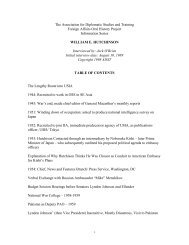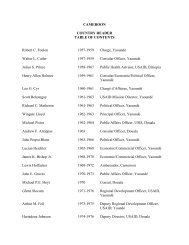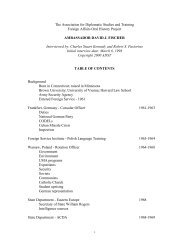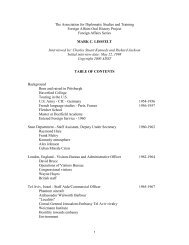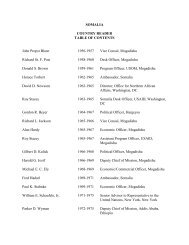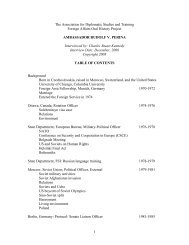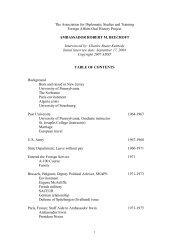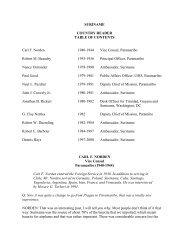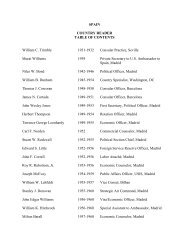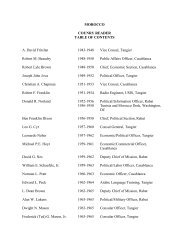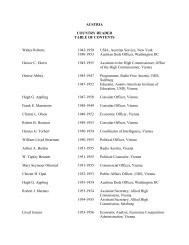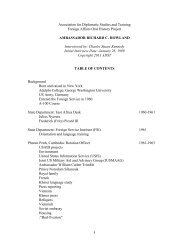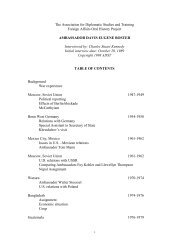1 The Association for Diplomatic Studies and Training Foreign ...
1 The Association for Diplomatic Studies and Training Foreign ...
1 The Association for Diplomatic Studies and Training Foreign ...
Create successful ePaper yourself
Turn your PDF publications into a flip-book with our unique Google optimized e-Paper software.
Q: <strong>The</strong>n we’ll go on to what you did after the transition worked its way out, <strong>and</strong> I haven’t<br />
asked you about how the transition team, in your particular aspect, fit with the State<br />
Department <strong>and</strong> CIA <strong>and</strong> all, were there any problems, <strong>and</strong> that sort of thing. So we’ll<br />
pick it up then.<br />
MILLER: Yes, all right.<br />
Q: Today is the twelfth of March, 2004. Bill, just to reprise a bit – who composed the<br />
transition team to the State Department?<br />
***<br />
MILLER: Well, the key players in the State Department transition team, I would say,<br />
were Tony Lake, Richard Moose, Leon Fuerth, Warren Christopher, <strong>and</strong> Brian Atwood.<br />
<strong>The</strong>se were all significant figures in previous administrations. <strong>The</strong>y had held high<br />
positions in <strong>for</strong>eign affairs. <strong>The</strong> transition team of Clinton, just as other president’s<br />
transition teams, was also composed of people who were involved in the campaign, so<br />
they were really political operatives. A number were office-seekers who had a place in the<br />
transition which they carved <strong>for</strong> themselves, in many cases, because of money given or<br />
services rendered during a campaign not because of experience or skills or ability in<br />
<strong>for</strong>eign affairs. <strong>The</strong>n there were the bureaucratic professionals, who were expected to<br />
continue to hold key positions in the new administration. <strong>The</strong> transition team I just<br />
described were in charge of putting together the policy papers <strong>for</strong> the new president <strong>and</strong><br />
the new administration, <strong>and</strong> to draw up lists of personnel who would be appointed by the<br />
president to key positions.<br />
It was very free-<strong>for</strong>m – one could not say it was an orderly process. It was governed by<br />
the collegiality <strong>and</strong> com<strong>for</strong>table familiarity of many of the individuals involved. <strong>The</strong>re is,<br />
in this sense, a continuity in our political system, even in <strong>for</strong>eign affairs <strong>and</strong> defense. <strong>The</strong><br />
people who go into policy work tend to do it <strong>for</strong> a lifetime, even if there are interruptions<br />
because of change of party <strong>and</strong> changes of direction in individual professions. So this was<br />
not a group of people without experience. <strong>The</strong>y were extremely experienced, <strong>and</strong> were<br />
able to draw on an enormous reservoir of experienced people. <strong>The</strong> non-governmental<br />
world is characterized by the think tanks, which are, in some respects, holding places <strong>for</strong><br />
people who would like to be running things in government <strong>and</strong> have done so in the past.<br />
It was the place of lawyers, who were involved in legal work on international matters, or<br />
they were doing legal work in campaigns. <strong>The</strong> Council on <strong>Foreign</strong> Relations in New York<br />
<strong>and</strong> Washington is another holding place, as are the faculties <strong>and</strong> institutes in the major<br />
universities. If you had to give numbers, there were several thous<strong>and</strong> people who were<br />
milling about in the transition, most, of course, were on the fringes hoping to break into<br />
the inner circles.<br />
<strong>The</strong> transition had two major categories. First, personnel – that is, who was going to be<br />
appointed to what position, <strong>and</strong> how they were to be vetted. <strong>The</strong> second was, what is the<br />
174




